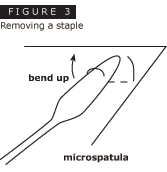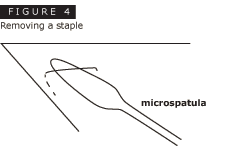NEDCC Staff
NEDCC
Andover, MA
Fasteners such as staples, paper clips, string ties, rubber bands, brads, and straight pins frequently damage documents. The damage may be physical: puncturing, tearing or distortion such as creasing -- or chemical, such as staining resulting from the rusting of metal fasteners.
Potentially damaging fasteners should be carefully removed from archival documents before the documents are put into long-term storage; however, if removing the fasteners will cause damage, then fasteners should be left in place.
Sealing wax, ribbons, thread ties or stitches, and unusual metal fasteners have value as artifacts and/or enhance the value of historic documents. The decision about the retention or removal of such fasteners is a curatorial one. When in doubt, these should always be left in place.
If records must be kept together by a fastener for the convenience of readers or staff, the U.S. National Archives recommends that a piece of archival bond paper be folded over the top of the group of documents, with a paper clip slipped over the protective overlay (Figure 1). Alkaline card stock is an acceptable alternative to bond paper. Potentially damaging original fasteners should first be removed.
Although they do not stain paper, plastic or coated metal clips will cause distortion of paper and are not recommended.
Removing Paper Clips
If the paper clip has not rusted and the paper is sturdy, a paper clip can be removed by gently prying it open. The safest method is to place the fastened papers with the short side of the paper clip facing up and the long side against a flat surface (Figure 2). Holding the long side of the clip down (through the paper) with one finger, carefully pull up on the short side with the thumb-nail of the other hand. If your fingernails are not long enough to get under the short side of the clip, use a small, flat tool. Conservators recommend microspatulas, which are available from sellers of conservation or scientific supplies.
With fragile papers or papers to which the clip has rusted: gently insert a small piece of clear polyester film (Melinex) between the clip and the paper on both sides; position the papers, and pry open as above. If the paper clip is severely rusted, first loosen it from the paper by scraping through the rust layer very gently with the tip of a microspatula before inserting the polyester and gently prying the clip open.
 |
 |
Removing Staples
Do not use staple removers. If the staple has not rusted, and the paper is sturdy, a staple can be removed by gently prying the prongs pen and carefully slipping them through the puncture holes. The safest method is to place the stapled papers on a flat work surface with the prongs of the staple facing up. Insert the tip of a microspatula between the paper and a prong of the staple and gently pry open one prong at a time (Figure 3).
Turn the stapled papers over and insert the microspatula between the staple and the paper, and carefully slip the prongs through the puncture holes (Figure 4).
With fragile paper, or papers to which the staple has rusted: gently insert a small piece of clear polyester film between the staple and the paper on both sides (Figure 5); position the papers, and pry open as above. Cut the polyester into strips which are slightly smaller than the width of a staple (or tapered) to make the film easier to insert. If the staple is severely rusted, first loosen it from the paper by scraping through the rust layer very gently with the tip of a microspatula before inserting the polyester, gently prying prongs open, and removing the staple.
Subject to curatorial decision and/or time or labor restrictions, unrusted staples may be left in place during long-term storage of historic documents, provided that environmental conditions are not conducive to further rusting. Staples should be carefully removed as necessary, for example for photocopying or digital scanning.
 |
 |
 |
Straight Pins
If the straight pin has not rusted, and the paper is sturdy, a straight pin can be removed by gently pulling it through the paper. With fragile papers or papers to which the pin has rusted, gently insert a small piece of clear polyester film between the pin and the paper at all three points of contact and carefully pull the pin through the paper (Figure 6). If the straight pin is severely rusted, first loosen it from the paper by scraping through the rust layer very gently with the tip of a microspatula before inserting the polyester and gently pulling the pin out.
 |
String Ties and Rubber Bands
Cut the tie or band and gently lift it off. Do not attempt to pull these fasteners over the ends of documents. If a rubber band has dried and adhered, gently scrape it off with a microspatula, being careful not to abrade or tear the paper. If the rubber band is soft and sticky, do not use solvents. Sticky residue may be gently scraped off with a microspatula. If this residue does not come off easily, interleave the sheets with silicone release paper to keep them from sticking together and consult a conservator.
references
National Archives and Records Administration. “Fastened Documents.” 2016. https://www.archives.gov/preservation/holdings-maintenance/paper#fastened
COPYRIGHT STATEMENT
© 2020. Northeast Document Conservation Center. All rights reserved.
